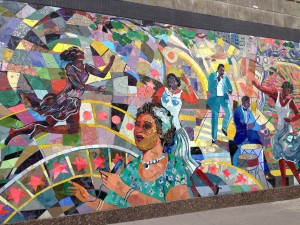Hurston ramps up her discussion of the politics of race in the last few chapters of Their Eyes Were Watching God. As we discussed earlier, she does, in previous chapters, expound ideas about race relations through Janie’s grandmother and through Mrs. Turner; however, each of those instances are, more or less, figures simply talking about racism/colorism while the events of chapters 18-20 display racism in action, with whites and blacks interacting directly with one another in a clearly politically charged dynamic. We see this when white people commandeer the bridge in the middle of the flood, turning desperate black people away to continue searching for safety (164); when the white men bully Tea Cake and other black men into burying the dead (169); in the disturbing fact that the corpses of black people are dumped into a hole while the bodies of white folks are treated dignifiedly to coffins (171); and in the all-white jury at Janie’s trial (185). Yet Hurston’s depiction of race relations is anything but simple– she does not pit blacks against whites in a battle of “good” vs. “evil” but rather complicates the picture through sympathetic white figures like Dr. Simmons (“The white doctor who had been around so long that he was part of the muck” (175)) and unsympathetic black figures like Mrs. Turner and the pack of colored people who attend Janie’s trial with “their tongues cocked and loaded” (185), ready to pull down a member of their own race. It seems, then, that Hurston is not trying to speak politically or to manufacture a narrative that will further some agenda for her race. Her priority is instead to document relations between humans, with issues of race being undeniably present in her chosen setting.
Even with this surge of racial politics at the end, the novel remains largely a story about Janie and the trials of her heart. In this sense, Hurston places the big (racism) side by side with the small (love) in a rather Woolfian maneuver. Zadie Smith, in a beautiful essay about the novel, denounces the idea that Hurston wrote just another simple romantic tale. She writes,
It’s about a girl who takes some time to find the man she really loves. It is about the discovery of self in and through another. It implies that even the dark and terrible banality of racism can recede to a vanishing point when you understand, and are understood by, another human being. Goddammit if it doesn’t claim that love sets you free.
I absolutely love Zadie Smith’s reading of Janie’s love as a sort of transcendental, liberating force. I think Hurston, though writing as a black female, wanted to write about something larger than issues of race, so she wrote about love. She presents Janie not simply as a black female but as a human. I think we might all identify with Janie to some extent, regardless of our race, gender, class, or education. Her experiences of “self-crushing love” (128), of Death with his “huge square toes” (84), and of Doubt, the “fiend from hell” (108), resonate across the entire human condition. Thus, by centering her novel around Janie and her escapades with love, Hurston makes her story universal, refusing to be pigeonholed by the constraints of racial politics.
